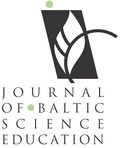BARRIERS TO STUDENTS’ CREATIVE EVALUATION OF UNEXPECTED EXPERIMENTAL FINDINGS
| Title | BARRIERS TO STUDENTS’ CREATIVE EVALUATION OF UNEXPECTED EXPERIMENTAL FINDINGS |
| Publication Type | Journal Article |
| Year of Publication | 2017 |
| Authors | Kadayifci, H |
| Journal | Journal of Baltic Science Education |
| Volume | 16 |
| Issue | 3 |
| Start Page | 414-428 |
| Pagination | Continuous |
| Date Published | June/2017 |
| Type of Article | Original article |
| ISSN | 1648-3898 |
| ISBN Number | E-ISSN 2538-7138 |
| Keywords | creativity barriers, laboratory work, students’ explanations, unexpected findings |
| Abstract | Science lecturers usually do not pay special attention to giving students the chance to evaluate persistent unexpected experimental findings that they cannot explain with their existing theories, propose alternative hypotheses and develop new theories in inquiry tasks at schools, despite the importance of these processes in scientific discoveries. Students’ reactions to this type of findings have been a subject for conceptual change studies that new theories were presented to explain the findings. This research, in contrast, examined students’ ways of interpreting their unexpected experimental findings about the molar mass of the sulfur element while hiding a new theory, and their barriers to discovering the scientific explanation of these findings, which is new to them, in the framework of the creativity paradigm. The research was conducted with 155 first-year undergraduate students who were enrolled in a chemistry laboratory course. A majority of the participants said that the unexpected findings might have resulted from experimental errors or methodical problems. Few students stated that these findings might be valid and have a new explanation. The barriers to students' discovery of new scientific explanation for findings were classified as: lack of pre-knowledge, obstacles of existing structures, failure of creative cognitive processes and social-personal blocks. |
| URL | http://oaji.net/articles/2017/987-1497964307.pdf |
| DOI | 10.33225/jbse/17.16.414 |
| Refereed Designation | Refereed |
| Full Text |
